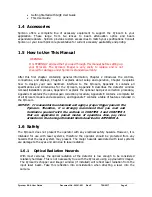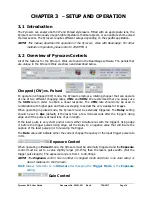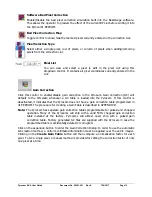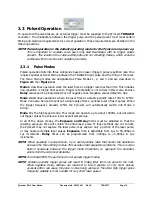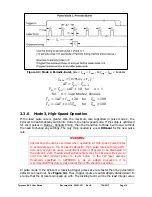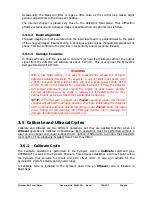
Pyrocam III
HR
User Guide
Document No. 50361-001
Rev E
7/18/2017
Page 19
Figure 3.3 : Mode 2, Periodic–Burst,
𝟑𝑯𝒛 < 𝒇
𝒕𝒓𝒊𝒈
< 𝒇
𝒎𝒂𝒙
,
𝟏𝟎𝒇
𝒕𝒓𝒊𝒈
< 𝒇
𝒃𝒖𝒓
< 𝟏𝟎𝟎𝟎𝑯𝒛
𝑓
𝑚𝑎𝑥
= (
8.705𝑚𝑠 + 𝑇
𝐸
)
−1
∆𝑇 = 𝑇
𝑝𝑛
− 𝑇
𝑝𝑛−1
𝑇
𝐷
= 𝑇
𝑝𝑛
− .1∆𝑇 + 10
for
𝑛 > 1
for
𝑛 = 1
use Mode 2, Periodic
𝑇
𝐸
= .1∆𝑇 + 𝑇
𝑙𝑤
+ 20
for
𝑇
𝑙𝑤
< 100
𝑇
𝐸
= .1∆𝑇 + 1.15𝑇
𝑙𝑤
for
𝑇
𝑙𝑤
≥ 100
3.3.6
Mode 3, High-Speed Operation
If the laser pulse rate is greater than the maximum rate supported in pulse mode 2, the
Pyrocam will automatically switch into mode 3, the high-speed mode. If the setup is optimized
for short pulses in Mode 2, Periodic timing, then the transition to Mode 3 will occur without
the need to change any settings. The only thing needed is a new
Ultracal
for the new pulse
rate.
WARNING:
Special care should be exercised when operating at high-speed pulsed rates
to avoid damage to the Pyrocam’s detector. High pulse rates with large ON-
time duty cycles can cause a significant amount of power to be dissipated in
the detector, even though small signal outputs may be observed. Be sure to
limit the total incident power to levels below ½ the CW laser damage
thresholds specified in APPENDIX A. As an added precaution, it is
recommended that duty cycles greater than 10% should be avoided.
In pulse mode 3, the Pyrocam is receiving trigger pulses at a rate faster than the pyroelectric
detector can read out. See
. Thus, trigger inputs are automatically divided down to
a range that the Pyrocam can keep up with. The dividing factor will be the least integer value


